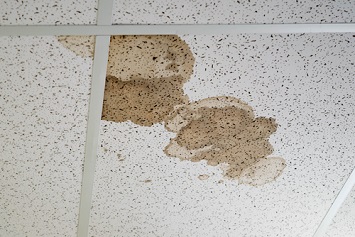Water intrusion can cause a host of issues impacting buildings and the health of the people who use them. Facilities managers, in particular those at hospitals and other medical facilities that serve potentially vulnerable populations, must be aware of this sometimes-invisible threat and take steps to protect against fungal exposure.

Inna_liapko / Shutterstock.com
Whether visible or hidden, and regardless of the age of the facility, water and water vapor can cause fungal growth and deterioration of building components, along with physical symptoms in people. Finding the cause of water intrusion and fixing it correctly makes the difference in providing healthcare consumers with the safe environments they expect.
What do you do if you suspect a water intrusion issue? You start by asking whether there is obvious evidence of moisture and whether there are impacts to people’s health.
Moisture in buildings exists as liquid water or as air vapor. Liquid water enters the building enclosure through leaks in roofs and around windows or other penetrations. It can also enter due to flooding during a natural disaster or result from an interior plumbing leak. Air vapor becomes liquid water when it contacts cool surfaces that lower the air temperature below the dew point (i.e., condensation). The liquid may then be absorbed by porous building materials and create a potential site for fungal growth.
If a building has visible leaks, you may be able to trace them to a failure of sealants or improperly installed flashing for windows, walls, roofing components, heating, ventilating, and air conditioning (HVAC) system penetrations. It’s important that these more obvious causes be addressed correctly so water intrusion problems don’t continue or reoccur later. Buildings with recurrent water intrusion problems often have maintenance issues that need attention, as well as potential mold growth on building materials.
Water vapor and condensation is a less-obvious type of moisture intrusion. An occurrence within walls or behind wall coverings is typically more difficult to diagnose. Air infiltration through the building enclosure during summer conditions may cause condensation on interior wall surfaces (on impermeable vapor barriers in the wall cavity or behind impermeable wall coverings). Air exfiltration during winter conditions may cause condensation on exterior sheathing materials in wall cavities.
Any type of water intrusion can lead to mold growth on building materials and may affect indoor air quality due to heightened airborne levels of fungi and the presence of more varied fungal species. This can cause symptoms in building occupants, such as mold allergies or more serious illnesses. Construction activities that disturb colonized building materials can also cause higher levels of fungi in the indoor air. Hospital staff might experience allergy-type symptoms in these cases, but immunocompromised or critically ill patients can contract life-threatening illness. Aspergillosis, caused by exposure to Aspergillus fumigatus and other Aspergillus species, is a known disease in healthcare settings where immunocompromised patients are exposed to fungi due to construction.
Certified industrial hygienists and building engineers that specialize in building enclosures can track down the sources of water intrusion and evaluate the building environment so that the building can be repaired and remediated.
While fixing water intrusion issues in a healthcare facility may seem overwhelming, companies like Terracon can help. Our team of facilities engineers and industrial hygienists have conducted large- and small-scope investigations and have experience in resolving complex moisture intrusion problems.
Common Causes of Water Intrusion by Building Type
New construction
- Improper installation of drainage planes, moisture barriers, air barriers, wall and window flashings, roof flashing and sealants
- Defective/faulty materials
- Failure to follow proper installation techniques
Existing facilities
- Lack of maintenance or improper maintenance techniques
- Failure of materials over time
- Building not constructed to meet demands of local climate
This article originally appeared in slightly different format here on Patient Safety & Quality Healthcare (PSQH).
| Michael S. Crandall, CIH, is a senior industrial hygienist in the Terracon Phoenix office. He has 40 years of experience in industrial hygiene and building investigations, working with residential, commercial, and institutional clients. |
